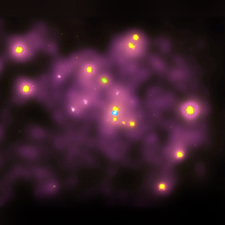January 14, 2000
CXC PR: 00-03
In its first look at the Andromeda Galaxy (M31), NASA's Chandra X-ray Observatory has found that the gas funneling into a supermassive black hole in the heart of this galaxy is a "cool" million degrees Celsius. This unexpected result adds one more quirk to the strange behavior previously observed at the center of M31.
A team of scientists from the Harvard-Smithsonian Center for Astrophysics, Cambridge, Mass., reported on this observation at the 195th national meeting of the American Astronomical Society in Atlanta, Ga. The team is led by Drs. Stephen Murray and Michael Garcia, and includes Drs. Frank Primini, William Forman, Christine Jones, and Ralph Kraft.
Chandra took its first X-ray picture of the Andromeda Galaxy with the Advanced CCD Imaging Spectrometer on October 13, 1999. More than100 individual X-ray sources were seen. One of these sources was at the previously determined position of the central supermassive black hole, which has the mass of 30 million suns. With many X-ray emitting stars in the center of M31 there was a slight chance that one of them might be at this position just by coincidence. The low temperature of the suspected central source, as compared to the other sources, gave the team the clue they needed.
"When we found that what we suspected was the central object was also anomalously cool, we KNEW we had it– one coincidence might be believable, but two was too much to ignore!" said Garcia.
While the gas falling into the central black hole is cool, it is only cool by comparison to the 100 other X-ray sources in the Andromeda Galaxy. To be detected by an X-ray telescope, the gas must have a temperature of more than a million degrees Celsius. The typical X-ray star in the Andromeda Galaxy has a temperature of several tens of millions of degrees. In contrast, the temperature of the supermassive black hole source is a few million degrees Celsius.
The Andromeda Galaxy is our nearest neighbor spiral galaxy at a distance of two million light years. It is similar to our own Milky Way in size, shape, and also contains a supermassive black hole at the center. This central black hole has always been a bit odd when compared to central black holes in similar galaxies. Based on its X-ray luminosity, it is much fainter in radio waves than expected.
Such behavior, coupled with Chandra's discovery of the low temperature gas, cannot be accommodated by standard models developed for supermassive black holes in galaxies like the Milky Way and Andromeda.
"The Chandra observation is telling us that an entirely different flow pattern is operating around the Andromeda black hole," said Dr. Eliot Quataert, of the Institute for Advanced Study, Princeton, N.J. "This will require a different class of models than usually considered."
One possibility is that the gas undergoes a large scale boiling motion which slows down the rate at which gas falls into the black hole.
The best previous X-ray pictures were not sharp enough to clearly distinguish the X-ray source associated with the black hole in the center of the Andromeda Galaxy nor did they give information about the temperature of the source.
"A good analogy might be to say that previous X-ray images were taken with a slightly out-of-focus black and white camera, while the Chandra image is taken with a sharp, color camera" said Murray.
Another intriguing feature of this observation is the detection of a diffuse glow that extends for a thousand light years around the central region. It is not known if this is due to many individual sources, or to a hot wind expanding out from the center.
"This is just a first, quick look at our nearest Milky Way analog," Murray emphasized. "I expect that our future pictures will lead to more exciting discoveries in the Andromeda Galaxy."
The ACIS instrument was built for NASA by the Massachusetts Institute of Technology, Cambridge, and Pennsylvania State University, University Park.
To follow Chandra's progress, visit the Chandra site at:
NASA's Marshall Space Flight Center in Huntsville, Ala., manages the Chandra program. TRW, Inc., Redondo Beach, Calif., is the prime contractor for the spacecraft. The Smithsonian's Chandra X-ray Center controls science and flight operations from Cambridge, Mass.
High resolution digital versions of the X-ray image (JPG, 300 dpi TIFF ) and other information associated with this release are available on the Internet at: http://chandra.harvard.edu/
MEDIA CONTACTS
Steve Roy
Marshall Space Flight Center, Huntsville, AL
Phone: 256-544-6535
Dr. Wallace Tucker
Chandra X-ray Observatory Center
Harvard-Smithsonian Center for Astrophysics, Cambridge, MA
Phone: 617-496-7998



